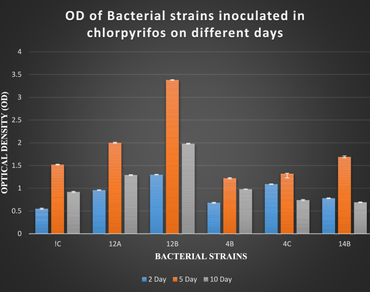Isolation, identification and characterization of microbes with a potential for organophosphate bioremediation
*Article not assigned to an issue yet
Research Articles | Published: 16 April, 2025
First Page: 0
Last Page: 0
Views: 534
Keywords: Pesticide, Chlorpyriphos, Bacteria, Degradation, Isolation
Abstract
In contemporary agriculture, pesticides such as organophosphates are frequently employed to boost crop yields and safeguard plants. However, they have negative effects on the ecosystem such as contaminated soil, nitrate leaching, decreased fertility, increased resistance to flora and fauna, and contaminated surface and groundwater. Chlorpyrifos [O,O-diethyl O-(3,5,6-trichlor- 2-pyridyl) phosphonothioate] is an organophosphate insecticide which is used extensively to control insects. An environmentally safe way to get rid of extra chlorpyriphos in soil and water can be microbial breakdown of pesticides. Effective strains for decomposing chlorpyriphos have been hard to isolate, with few cases documented, despite its extensive use since 1965. For our current study, six bacterial species were identified by isolating them from heavily pesticide-contaminated locations of the National Capital Region in and around Delhi. Further, they were assessed on nutrient- and enrichment-media for their degradation ability of chlorpyriphos at concentrations of 0.1%, 1%, and 10% by analytical techniques like thin layer chromatography (TLC) and gas chromatography (GC). As a result, TLC demonstrated complete degradation on the 10th day, however, the GC study showed different degradation levels of the Chlorpyrifos in nutritional media. These results demonstrate the future implication of these strains for bioremediation of habitats contaminated with chlorpyriphos.

References
Atalay S, Ersöz G (2016) Novel catalysts in advanced oxidation of organic pollutants. Springer, Berlin
Bergey DH (1994) Bergey’s manual of determinative bacteriology. Lippincott Williams & Wilkins, Philadelphia
Bhatti AA et al (2017) Actinomycetes benefaction role in soil and plant health. Microb Pathog 111:458–467
Cardoso IM et al (2021) Advanced oxidation processes coupled with nanomaterials for water treatment. Nanomaterials 11(8):2045
Dhaliwal G et al (2015) Crop losses due to insect pests: global and Indian scenario. Indian J Entomol 77(2):165–168
Dimri AG et al (2020) Morphological and biochemical characterization of food borne Gram-positive and Gram-negative bacteria. Sci Arch 1(1):16–23
Dua K, Joshi N (2020) Isolation, screening and characterization of potential chlorpyrifos utilizing bacteria from Buddha Nullah as well as agricultural soils of rural Ludhiana, Kapurthala and Shaheed Bhagat Singh Nagar, Punjab. Progress Agric 20(1and2):6–14
Hossain ME et al (2022) Chemical fertilizers and pesticides: impacts on soil degradation, groundwater, and human health in Bangladesh. Environmental degradation: challenges and strategies for mitigation. Springer, Berlin, pp 63–92
Iqbal MA, Bartakke K (2014) Isolation of pesticide degrading microorganisms from soil. Adv Biores 4:164–168
Kumar M et al (2021) Biodiversity of pesticides degrading microbial communities and their environmental impact. Biocatal Agric Biotechnol 31:101883
Lykogianni M et al (2021) Do pesticides promote or hinder sustainability in agriculture? The challenge of sustainable use of pesticides in modern agriculture. Sci Total Environ 795:148625
Marican A, Durán-Lara EF (2018) A review on pesticide removal through different processes. Environ Sci Pollut Res 25:2051–2064
Maulana A et al (2024) Biodegradation of chlorpyrifos by microbes: a review. Trop Aquat Soil Pollut 4(1):10–26
Nandhini A et al (2021) Chlorpyrifos in environment and food: a critical review of detection methods and degradation pathways. Environ Sci Process Impacts 23(9):1255–1277
Nwaogu L et al (2008) Degradation of diesel oil in a polluted soil using Bacillus subtilis. Afr J Biotechnol 7(12):1939
Pathak VM et al (2022) Current status of pesticide effects on environment, human health and it’s eco-friendly management as bioremediation: a comprehensive review. Front Microbiol 13:962619
Popp J, Hantos K (2011) The impact of crop protection on agricultural production. Stud Agric Econ 113(1):47–66
Raffa CM, Chiampo F (2021) Bioremediation of agricultural soils polluted with pesticides: a review. Bioengineering 8(7):92
Rajak P et al (2023) Agricultural pesticides–friends or foes to biosphere? J Hazard Mater Adv 10:100264
Saleh IA et al (2020) Removal of pesticides from water and wastewater: chemical, physical and biological treatment approaches. Environ Technol Innov 19:101026
Shattuck A et al (2023) Global pesticide use and trade database (GloPUT): new estimates show pesticide use trends in low-income countries substantially underestimated. Glob Environ Change 81:102693
Sparks TC et al (2019) The new age of insecticide discovery-the crop protection industry and the impact of natural products. Pestic Biochem Physiol 161:12–22
Stankovic S et al (2020) Practical approaches to pest control: the use of natural compounds. Pests, weeds and diseases in agricultural crop and animal husbandry production. IntechOpen, London
Tudi M et al (2021) Agriculture development, pesticide application and its impact on the environment. Int J Environ Res Public Health 18(3):1112
Zhan H et al (2020) New insights into the microbial degradation and catalytic mechanism of synthetic pyrethroids. Environ Res 182:109138
Ali S et al (2021) Environmental and health effects of pesticide residues. Sustainable agriculture reviews 48: pesticide occurrence, analysis and remediation vol. 2 analysis, pp 311–336
Baweja P et al (2020) Fertilizers and pesticides: Their impact on soil health and environment. In: Giri B, Varma A (eds) Soil Health. Soil Biology, vol 59 Springer, Cham
Kaur R et al (2021) Pesticide residues degradation strategies in soil and water: a review. Int J Environ Sci Technol 20:3537–3560
Lehman DC (2014) Biochemical identification of gram-negative bacteria. Textbook of diagnostic microbiology-e-book, p 182
Sharma M et al (2017) Biological control as a tool for eco-friendly management of plant pathogens. Advances in soil microbiology: recent trends and future prospects: volume 2: soil-microbe-plant interaction, pp 153–188
Singh NS et al (2018) Pesticide contamination and human health risk factor. Modern age environmental problems and their remediation, pp 49–68
Zaller JG, Zaller JG (2020a) Pesticide impacts on the environment and humans. In: Daily poison: pesticides-an underestimated danger. Springer, Cham, pp 127–221
Singh BK et al (2006) Microbial degradation of organophosphorus compounds. FEMS Microbiol Rev 30(3):428-71
Mallick K et al (1998) Bacterial Degradation of chlorpyrifos in pure cultures and in soil. Bull Environ Contam Toxicol 62:48–54
Author Information
Amity Institute of Biotechnology, Amity University Chhattisgarh, Raipur, India